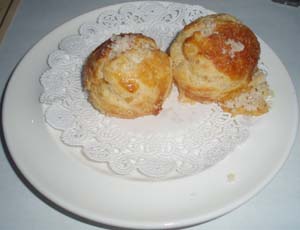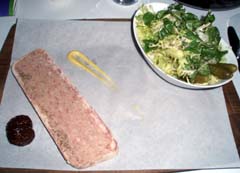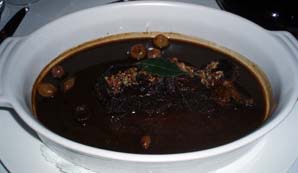The Four Seasons
 Saturday, May 19, 2007 at 01:32PM
Saturday, May 19, 2007 at 01:32PM 
Note: Click here for a more recent review of the Four Seasons.
*
The Four Seasons is an iconic restaurant. Located in the Seagram Building at 52nd & Park, it opened in 1959 to immediate acclaim. Architect Philip Johnson designed the interior, which cost $4.5 million to build. Even today, that would be a large sum to invest in a restaurant. The space is landmarked—the only Manhattan restaurant to be so designated. (There are other restaurants in landmarked buildings, but no other restaurants that are landmarks themselves.)
Reviewing for The New York Times on October 2, 1959, Craig Claiborne wrote:
There has never been a restaurant better keyed to the tempo of Manhattan than the Four Seasons, which opened recently at 99 East Fifty-second Street.
Both in décor and in menu, it is spectacular, modern and audaceous. It is expensive and opulent and it is perhaps the most exciting restaurant to open in new York within the last two decades. On the whole, the cuisine is exquisite in the sense that la grande cuisine française is exquisite.

The Pool RoomThese days, the Four Seasons is mostly known as a power lunch destination. In the famous grill room, one may rub noses with Hillary Clinton, Henry Kissinger, Mike Bloomberg, or Sandy Weill. The serene pool room is one of the city’s most romantic dining spots. Celebrities have flocked there from the beginning. John F. Kennedy had his 45th birthday party at the Four Seasons, of which the restaurant doesn’t fail to remind you: a copy of the menu for that occasion is bound into the wine list.
For many years, the kitchen at the Four Seasons turned out food that justified all that attention. eGullet historian Leonard Kim found numerous Times reviews from 1971 onward—generally three stars, although in 1979, its twentieth anniversary year, Mimi Sheraton demoted it to two. Her successor, Bryan Miller, restored it to three stars in 1985. He re-affirmed that rating in 1990, as did Ruth Reichl in 1995.

The BarIn recent times, no one has suggested that the Four Seasons is a hotbed of culinary invention. Earlier this year, Frank Bruni demoted the Four Seasons to two stars, where it is likely to remain for a very long time. Christian Albin has been in charge of the kitchen for the last seventeen years, and though the menu does change with the seasons, Albin is not a risk-taker. He dutifully turns out the continental classics that the restaurant’s conservative clientele demands. Bruni found, and I concur, that the cooking can be terrific, but it can be boring and sloppy too.
Though I expected no pyrotechnic fireworks on the plate, I nevertheless craved a visit to the legendary Four Seasons, and my friend Kelly’s 37th birthday provided the occasion. Frank Bruni warned that this is “a restaurant that runs on two tracks — one for the anonymous, another for the anointed.” As Kelly and I are clearly in the former category, I wondered how we’d be treated.
I needn’t have worried on that score. I requested a Pool Room table, and we were indeed seated there, close to the famous pool. The serving staff at the Four Seasons seem mildly bored with their lot in life, but they provided classic, efficient service. When I arrived a bit wet (it was raining, and I’d forgotten my umbrella), the host handed me a napkin to dry off with. I started the evening with a drink at the bar, and the tab was transferred to my dinner bill, as it should be at any fine restaurant. At no point were we made to feel anything less than special.
 The prices are eye-popping, with most appetizers $18–42 (not counting caviar at $140), and most entrées $37–56 (with lobster $75 and Kobe beef $125). Of sixteen entrées, eight are over $50, and only three are under $40. As far as I know, it is the most expensive à la carte menu in town. While we enjoyed almost everything we had, it was one of those celebratory occasions when price is really beside the point. Viewed in the cold light of day, very little that the kitchen produces can justify these prices.
The prices are eye-popping, with most appetizers $18–42 (not counting caviar at $140), and most entrées $37–56 (with lobster $75 and Kobe beef $125). Of sixteen entrées, eight are over $50, and only three are under $40. As far as I know, it is the most expensive à la carte menu in town. While we enjoyed almost everything we had, it was one of those celebratory occasions when price is really beside the point. Viewed in the cold light of day, very little that the kitchen produces can justify these prices.
To start, I had the Beef Tartare with Osetra Caviar ($38; above right), an assembly-line dish that had none of the tangy, spicy seasoning I was longing for. Kelly started with an assortment of oysters and clams ($25; below), with which she seemed satisfied.


I was keen to have the duck, which was one of the few dishes Frank Bruni really loved. Fortunately, Kelly was of the same mind, since it’s served only for two ($55 per person). As Bruni put it, the duck, carved tableside, “emerges from a Peking-style sequence of many days and steps, is as astonishing as ever, a knockout of crunchy skin and succulent meat.” Have I ever had duck better than this? Not that I recall.

Kelly loves soufflés ($15), so we ordered them for dessert: strawberry for her, Grand Marnier for me. We both thought the strawberry was a little better, though neither one matched the absurdly decadent chocolate soufflé we had at Town.


I alerted the management in advance that this was Kelly’s birthday, and they brought one of the odder birthday cakes I’ve seen: a large ball of cotton candy with a candle on top. It was probably the most creative idea they had, but after a few bites the cotton candy quickly became cloying. There was an attractive selection of petits-fours, and we finished nearly all of them.
For a restaurant of this calibre, I was surprised to find that the wine list was rather unimpressive. Indeed, more pages of the little book are devoted to photos from the restaurant’s past than to wines. However, I was happy to find a wonderful 1999 Gewurtztraminer from Alsace for $76. At the restaurant’s overall price level, I considered it a bargain. It arrived at our table before we were done with our champagne, and the server was astute enough not to pour it right away—a nice touch that many restaurants wouldn’t get right.
While I wouldn’t visit the Four Seasons for the food alone, the whole package is certainly impressive. For the right special occasion, I’d be happy to dine there again.
The Four Seasons (99 East 52nd Street between Park and Lexington Avenues, East Midtown)
Food: **
Service: ***
Ambiance: ****
Overall: **½















